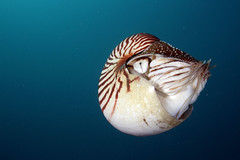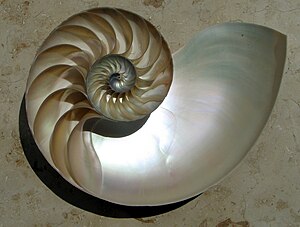It looks like we're going way back in time for this one, indeed some Nautilus have barely changed for 500 million years. They look quite a lot like prehistoric
ammonites, although ammonites are actually more closely related to octopus and squid than to nautilus. Nautilus are all on their own,
the only living cephalopod to have an external shell - all others have their shell within their body and some have none at all. At least it's all smooth and beautiful with its stripy white and brown-orange-copper colour. Worth having on the outside I think.
 |
| RealMonstrosities.com |
There are just 6 known species of nautilus today, the largest of which have a shell diameter of about 27 centimetres, the smallest around 16 centimetres. In fact, some of them are known only from their washed up shells. Why such mystery? Because nautilus spend their days at depths of 300 metres (980 ft), rising up at night to feed on the bounty of their Indo-Pacific home. Some will stop at around 100 metres (330 ft), others will go almost to the very surface. This is the reason for their lovely colours, their shell aids in camouflage. The stripes at the top help it to blend in with the surrounding dark water when seen from above. The underside is bright white, blending into the light water when seen from below
The nautilus can also completely retract into its shell and shut the aperture with a tough, leathery hood. Very few creatures can get through this formidable calcium carbonate defense. Those that can, such as other cephalopods and triggerfishes, are the kind of animals that crack crabs open. It requires extremely powerful beaks or jaws.
Nautilus have none too shabby beaks themselves. They are predators that feed mainly on crustaceans and small fish which they capture with their 90 or so tentacles. 90!
Other cephalopods have 10 at most,
and they are covered in suckers. The nautilus has no suckers at all, they have grooves and ridges instead which still provide them with an incredible grip. You can actually tear off tentacles by pulling at whatever they are gripped on to. Just... don't.
Nautilus don't hunt using sight because,
unlike other cephalopods, they have rubbish eyesight. Without a lens, nautilus eyes work in a manner similar to a pinhole camera, basically a box with a hole in it. Right next to each eye are two small tentacles covered in cillia, little hairs. These are used to smell their surroundings and find out what's going on.
Luckily, they don't actually need to eat much because they lead a very relaxed life. Nautilus only live in one part of their shell, the big chamber near the opening, obviously. When they first hatch they have four chambers in total. As they grow, they build a new, bigger chamber, move into it and close off the old one until they have about 30 or more chambers as they enter old age. Which is about 20 for a nautilus, which is very old for a cephalopod, as it happens.
Anyway, all these chambers have a little hole in them. So, even though the nautilus lives in just one chamber, he has a line of tissue called a siphuncle, which reaches all the way back through the coiling shell. Like all cephalopods, the nautilus has a siphon called a hyponome. Although
unlike other cephalopods, who have a muscular tube as a siphon, the nautilus' one is just a flap. Anyway, this is used to draw water in and out to be used as jet propulsion. Fluid and gas can also be pumped into the chambers behind (and above, I suppose) the nautilus to provide buoyancy control. This doesn't use much energy, so the nautilus can just stretch his tentacles and chill.
As well they might. Males have four tentacles specially designed for handing over (tentacling over) sperm to the female. She attaches the eggs to rocks in shallow water, where it can take 8 months to a year for the 3 centimetre (1.2 in) long youngsters to hatch. She will have to keep her strength up though, because
unlike any other cephalopod she is able to mate more than once in her life. How's that for a happy ending?
.....
Check out the little 'Nautilus Depth' picture. I've added that to all the other
deep sea posts and to the
Krill one. I hope you'll find them useful.
The video above is taken from the Planet Earth series.
US: UK:
 Image by PacificKlaus via Flickr
Image by PacificKlaus via Flickr
 Image via Wikipedia
Image via Wikipedia Image via Wikipedia
Image via Wikipedia
No comments:
Post a Comment